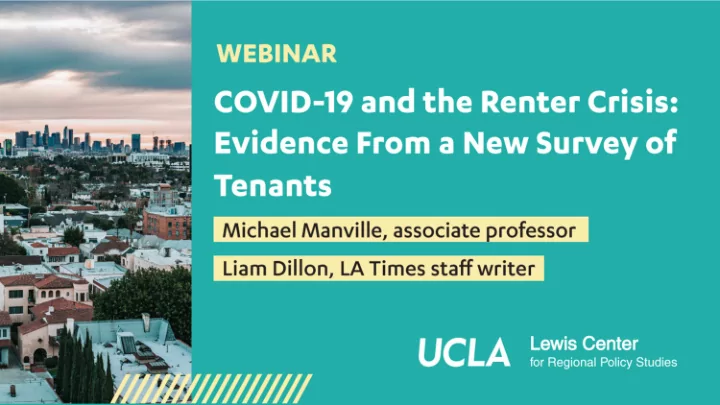

As a land grant institution, the UCLA Lewis Center for Regional Policy Studies acknowledges the Gabrielino/Tongva peoples as the traditional land caretakers of Tovaangar (Los Angeles basin, So. Channel Islands).
Read the Report lewis.ucla.edu/research/covid19-and-renter-distress/
COVID-19 and the Renter Crisis
Acknowledgments ● Co-Authors ○ Paavo Monkkonen, Michael Lens, Richard Green ● Research Assistance ○ Miriam Pinski, Xavier Kuai ○ Lewis Center Staff ● Funding ○ California Community Foundation, UCLA Luskin Institute on Inequality and Democracy, UCLA Luskin School Dean’s Office, UCLA Ziman Center for Real Estate, USC Lusk Center for Real Estate
COVID-19 and Renters How are tenants coping? How prevalent is nonpayment? Who is it affecting? How are landlords reacting?
What Makes Renters Vulnerable? ● Attributes of Renters Lower median income: ($40,000 to $78,000) ○ Lower median savings: ($3,700 to zero) ○ Issue isn’t that all renters are low-income, but that most low-income people ○ rent à Lower-income people more likely to lose work in recessions ○ ● Attributes of Renting Fewer options - renters can’t sell or easily lease unit for cash ○ Less legal protection ○
A Renter Comes up Short: What Happens? Tenant could: ● Pay rent but forego other consumption (food, medicine, etc) ○ Put rent on a credit card, ask friends for help, get an emergency loan ○ Pay late while balancing the two tactics above ○ Only pay in part ○ Eviction risk or Not pay at all ○ debt Decision will depend both on renters’ resources and expectations about landlord ○ If tenant does not pay in in full, landlord could: ● Negotiate a repayment plan ○ Threaten or begin eviction ○ Decision will depend on landlord’s savings, and perception of demand ○ Bigger, corporate landlords may have higher reserves and smaller chance of ○ nonpayment Mom-and-Pop landlords might have smaller reserves and a larger chance ○
Data Sources
US Census Pulse Survey ● Rapid-response COVID-related survey, administered weekly for 3 months About 8,000 total responses from LA and Orange Counties ○ “Did you pay your last month’s rent or mortgage on time? Select only one ○ answer. [Yes/ No/ Payment was deferred]” Asks about lost work and income, as well as basic demographics ○ Only asks if payment was late, does not follow tenants over multiple ○ months, no information about type of unit, level of rent, type of landlord, how payment was made, eviction threats
LA County Renters’ Survey Original UCLA/USC Survey of 1,000 LA County Renters, conducted by Soapbox Sample ○ Smaller and less representative than Pulse, but more detail ○ ● Three months of data from each respondent Was rent paid in full or in part, on time or late? Repayment plan or eviction threat? Method of payment: cash, loans, credit cards, etc Type of unit Type of landlord Level of rent
Results: Pulse
Late payment in LA and the US averages about 16 percent, but is much more volatile in LA
Across all weeks, Blacks and especially Hispanics are substantially more likely to be behind on rent - Blacks especially early in the crisis
Results derived from regression analysis of 12 weeks of Pulse data
Problems Beyond Late Payment ● Late payment is highly correlated with depression and anxiety, as well as difficulty getting food. Notably higher for paying tenants as well.
Results: LA County Renters’ Survey
Making Rent: Lots of Payment, But Real Problems Too ● Most renters (78 percent) were able to pay rent in full and on time each month ● 22 percent paid late in at least one month ● Of the 22 percent paying late, about a quarter had paid by month’s end ● à 17 percent of renters didn’t fully pay rent in at least one month. ● 7 percent (137,000 HHs) didn’t pay at all in at least one month. ● 2 percent (40,000 HHs) didn’t pay any rent in any month ○ Poorest renter households twice as likely to be in this group
Tenants renting from friends and family are 12 percent of sample and 25 percent of households that could not pay in at least one month Large landlords are over 40 percent of HHs and under 35 percent of nonpayment
Large racial gaps in late payment, smaller in partial nonpayment, smallest in complete nonpayment
Regression Analysis What matters in these regressions: Losing jobs, hours and income Getting sick with COVID Getting help from the government What doesn’t: Rent levels Race Income (Latter two might be sample size)
What Happened to the HHs Not Paying? ● Most discuss or enter into repayment plans ● About 15 percent (98,000 HHs) threatened with eviction ● 5 percent (40,000 HHs) report having eviction initiated against them ● Eviction sample is small, but no differences by race/income/rent level ● Controlling for nonpayment, eviction threat or initiation much more common among smaller landlords ○ -Zero eviction threats or initiations from large management companies
Even Many Households Paying in Full Are in Trouble Over 20 percent have dipped into savings, over 10 percent need help from friends Just under 10 percent have used credit cards or emergency loans Among HHs behind in rent, all these methods much more common Over 40 percent of HHs unable to pay report taking out a payday loan, almost 40 used cred
Conclusions: An Income Crisis Atop a Housing Crisis ● Housing in LA is far too expensive, but ● That is not the trigger of COVID-related tenant distress ● Overwhelming caused by sickness and/or loss of income ● Rent didn’t change – ability to pay did ● Even many tenants not in arrears are losing savings or going into debt ● These facts, combined with evidence showing positive effects of unemployment insurance, suggests policy action: ● Get money into hands of renters ● Virtually no HHs that didn’t suffer sickness or job loss failed to pay rent
Thank you! Questions?
Recommend
More recommend